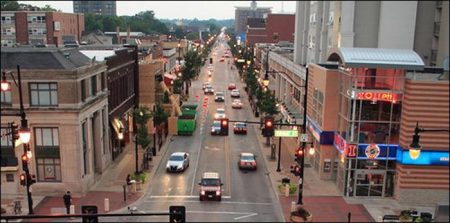Champaign (740 alt., 75,254 pop.) and Urbana (750 alt., 38,463 pop.) lie in the east central section of the State in the center of a fertile prairie. Although they are divided by no more than a street, they are individually incorporated and preserve a vigorous independence.
The campus of the University of Illinois, which lies largely in Urbana at the dividing line of the two cities, is the heart of the two cities, both physically and economically. Interposing what is virtually a third city between the two, it far surpasses any single local industry in importance. Here the rivalry of town and gown founders on the rock of commerce. For nine months of each year the population is increased; merchants watch the registration figures closely, and dress their shops to cater to the youthful taste.
Should a volcanic upheaval cover Champaign and Urbana, future archaeologists would encounter little difficulty in piecing together the mosaic. Although not an industrial town, Champaign is the worldlier of the two, with its railroads, its bustling business district, and its 20odd factories that manufacture tiles, concrete mixers, gloves, soy bean products, and a dozen others. Urbana, which is heavily wooded, gives the impression of being more leisurely and maintains that subdued dignity characteristic of a Midwest county seat. Certain features would identify the campus section even if its university buildings were completely razed.
At the campus edge cluster numerous “coke ‘n smokes,” elaborate confectioneries, counterparts of which are to be found only in university towns. And deep into both towns, north, east, and west of the campus, runs street after street of student rooming houses, varying in size from seven to thirty rooms, each with the ubiquitous double-decked bed, goose-neck study lamp, and capacious book rack. Interspersed are the fraternity and sorority houses, individual in architectural style and more elaborately furnished, but unmistakably indigenous to the American university. It was the fraternity houses of Illinois that inspired Fraternity Row, a popular novel of the 1920’s by Lynn and Lois Montross, both of whom were students here.
Settled in 1822 by Willard Tompkins, Urbana is some 30 years older than Champaign. In 1833 it was designated seat of newly formed Champaign county, and settled back in anticipation of a leisurely and steady growth. In 1854 came a rude awakening. The Illinois Central Railroad, first line of any importance in the State, was pushing south with its rails. At Urbana the engineers laid out three possible routes, two through the city and one about two miles west. To Urbana’s dismay, the last route was chosen. What prompted this choice lies buried in rumor and counter-rumor, which hint at covert real estate deals. Swarms of laborers swung their hammers and eventually moved on, leaving new rails glistening on the prairie two miles out of town.
Urbana, faced with the choice of moving to the depot or attempting to maintain its existence without a railroad, chose the latter. Almost immediately a town referring to itself as West Urbana sprang up around the depot, but farmers avoided confusion by calling the two towns the Depot and Old Town. In a bill for incorporation as a city in 1855, Urbana included a clause authorizing the annexation of the new town. Indignant Depot residents successfully fought the bill and in 1860 incorporated under the name of Champaign. The cleavage thus established has since been maintained.
Champaign boomed as a trade center and soon passed Urbana in population. The rich prairies, opened for cultivation by the railroads, poured their bumper crops into the railroad town. Upstart and flushed with prosperity, Champaign attempted to wrest the county seat from Urbana, which, realizing that the courthouse was its chief asset, met the assault with successful vigor.
In the middle of the nineteenth century arose a great clamor from the people of Illinois for an industrial college, at which their children could receive practical training as well as a classical education. In 1862 Congress passed the Morrill Act, providing generous land grants to the several States for the establishment of schools “to teach such branches of learning as are related to agriculture and the mechanic arts.” A scramble for the new college immediately ensued.
A few years earlier Champaign and Urbana, with the aid of several eastern promoters, had begun constructing between the two towns a seminary for higher education. The rival cities buried the axe in the log of expediency, and collaborated on a plan to obtain the new “Agricultural College” by proffering the seminary building as its nucleus. A powerful lobby was sent to Springfield; in 1867, to the surprise of older communities, Urbana was named the home of the new State college. The choice was bitterly assailed by Chicago and other cities, but by the end of the century the new institution was functioning smoothly and criticism had turned to praise.
Visits: 78



